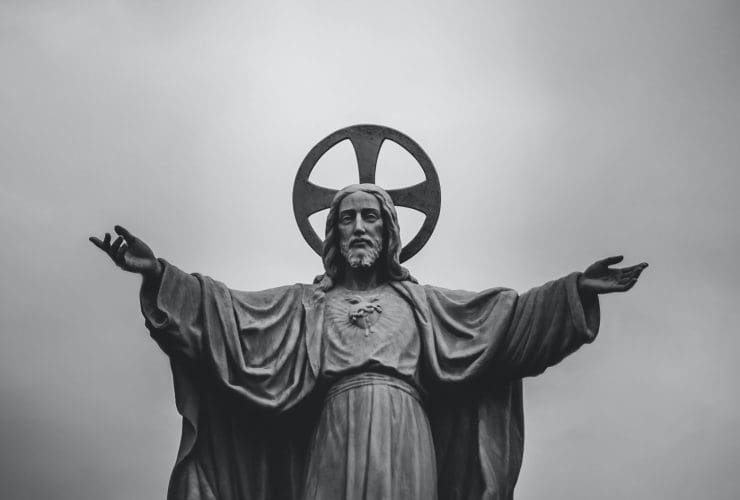Q:
“There seems to be a contradiction between Genesis 32:30 and John 1:18 in regards to seeing the face of God and being able to live. Can you explain?”
Paula
Hey Paula, I think this supposed contradiction is easily resolved through a deeper understanding of Christ in the Old Testament. But to answer your question specifically (and quickly), take note of what Jacob says: “I saw God face to face, yet my life was spared” (v.30). God could have killed Jacob, but Jacob recognized that God chose not to. In fact, God does this quite frequently throughout the OT (Judges 6:22, 13:21-22). God can also choose to conceal Himself or reveal Himself only partially as to not kill a person, such as the case with theophanies in the OT where the Angel of the Lord appears in various forms from a burning bush (Exodus 3:2-6; Acts 7:30) and a pillar of cloud (Exodus 23:20-23) to human form (Joshua 5:13-15) and so on. Why so? According to God, no one can see the Father in His full glory and live, which is the theological context of John 1:18. The Apostle Paul even confirms this understanding to Timothy: “God, the blessed and only Ruler, the King of kings and Lord of lords, who alone is immortal and who lives in unapproachable light, whom no one has seen or can see. To him be honor and might forever. Amen.” (1 Timothy 6:15-16) This understanding of God has never changed. In fact, Exodus 33 addresses this exact topic:
As Moses went into the tent, the pillar of cloud would come down and stay at the entrance, while the Lord spoke with Moses…. The Lord would speak to Moses face to face, as one speaks to a friend. Then Moses would return to the camp, but his young aide Joshua son of Nun did not leave the tent. (Exodus 33:9, 11; cf. Deuteronomy 34:10)
Now we zoom into the Tabernacle as Moses inquires of God:
Then Moses said, “Now show me your glory.”
And the Lord said, “I will cause all my goodness to pass in front of you, and I will proclaim my name, the Lord, in your presence. I will have mercy on whom I will have mercy, and I will have compassion on whom I will have compassion. But,” he said, “you cannot see my face, for no one may see me and live.”
Then the Lord said, “There is a place near me where you may stand on a rock. When my glory passes by, I will put you in a cleft in the rock and cover you with my hand until I have passed by. Then I will remove my hand and you will see my back; but my face must not be seen.” (Exodus 33:18-23)
As I said before, this instance explicitly addresses the full versus partial revelation of God’s glory. Since God is the “Author of life”, He alone can choose to take or spare life (Judges 6:22). In short, there is no contradiction.
How does this work exactly?
The difficulty some people have with this interpretation is that God is traditionally understood as a nonmaterial being or spirit and, therefore, invisible. So, if God is invisible, how can we actually see him with our own eyes? Consider what Job says after God judges him: “My ears had heard of you but now my eyes have seen you.” (Job 42:5) Despite the biblical writer’s often speaking in analogy or simile, which is to use “like” or “as” descriptions to point to a truth, such as when we say, “I see your heart” or “I see who you really are,” or when Christ said, “The eye is the lamp of the body” (Matthew 6:22), I think these prophetic declarations of seeing God “face-to-face” are also literal. There are a couple ways to look at this, but here’s three for your consideration.
1. Seeing God in Christ
First, consider Jesus Christ in the NT who holds people, particularly Philip, accountable for not seeing God the Father in Him before his resurrection and glorified body (John 14:8-10; Matthew 12:22-32). God is concealed yet Christ. And yet, everyone saw the “Author of life” (Acts 3:15) and spoke with Him “face to face, as one speaks to a friend”. In this view, it’s not actual physical eyesight we’re speaking about, but the light of the eye: spiritual discernment.
2. Glorified in Spirit
For a person to see God’s full glory and live would, presumably, require that person to also be eternally glorified in flesh and spirit (Romans 8:28-30), that is adoption of sonship, or more crudely put, dead. This will be fulfilled on the Day of resurrection and salvation for those who have faithfully loved the Lord. Consider the prophet Job: “And after my skin has been destroyed, yet in my flesh I will see God; I myself will see him with my own eyes—I, and not another. How my heart yearns within me!” (Job 19:26-27) Or when Christ said, “Blessed are the pure in heart, for they will see God.” (Matthew 5:8) And when Christ returns it is prophesied that the true believers “will see his face, and his name will be on their foreheads”. (Revelation 22:4) These are prophetic statements of a future reality, not mere word pictures. Alternatively, we may never be able to truly see God in His full glory and that is precisely why He assumes limited forms such as the Angel of the Lord or assumed flesh, died, and rose again–––He is a loving God showcasing His desire for us to speak with Him face to face. While that definitely applies here on earth, whether that applies in the new heavens and new earth is beyond my pay grade. After all, Jesus Christ is the only one who has seen the Father in His full glory (John 6:46).
3. Angel of the Lord
A trinitarian understanding of God in the OT, with a special emphasis on the Angel of the LORD in human form, definitely helps clear up any issue seeing God, such as the case with Abraham’s meal with the three visitors, Jacob wrestling with a “man”, Joshua bowing on holy ground, and even Daniel’s vision (Genesis 18:1-3, 22:12-15, 31:11, 32:30, 48:16; Joshua 5:13-15; Daniel 10:5-6,10-21). We have all heard it said that God the Father is not the same person as God the Son, Jesus Christ, so I need not hash it out here. Long story short, theologians have rightfully recognized this Angel of the Lord who appears in human form to be the pre-incarnate Christ in the OT because He takes on God’s authority: receives worship by Moses and Joshua, judges the earth (Genesis 18:25), governs life (Genesis 16:10; Judges 13:21-22), forgives sin (Genesis 48:16; cf. Exodus 23:21; cf. Isaiah 42:8,43:25), et cetera; a fact that normal angelic beings reject (Revelation 19:10, 22:8-9; Jude 1:9). The fact that the Angel of the Lord takes on human form also harkens, or foreshadows rather, Christ taking on human flesh. Furthermore, there are also strong apocalyptic visual parallels between Daniel’s vision of a “man clothed in linen” (Daniel 7:9-10,10:5-6,10-21) and John’s final vision of Jesus Christ (Revelation 1:12-18,14:14,19:11-16), both of which appear equal to God in authority[1]. In all cases, whether it is a physical manifestation or a vision of Christ, the Angel of the Lord is God, and the prophets see Him and live to speak another day.
I hope that helps with your difficulty, Paula. Have a great new year and God bless you in 2022!

Matlock Bobechko is the Chief Operating/Creative Officer of Bible Discovery. He is an eclectic Christian thinker and writer, award-winning screenwriter and short filmmaker. He writes a blog on theology, apologetics, and philosophy called Meet Me at the Oak. He is also an Elder at his local church.
[1] Biblical scholars Alan Segal and Michael Heiser have aptly identified the historical relationship between God and the Angel of the Lord, particularly, in human form. Torah scholars during the Second Temple period held to a two Yahweh theology, where there were two powers in heaven, both God yet distinct. Christianity did not invent the trinity; the early Christians were primed to believe in Christ as saviour when they were fervent orthodox Jews because it was deeply woven into the Judaic framework long before Christ was born.
Michael Heiser, Two Powers in Heaven. https://drmsh.com/the-naked-bible/two-powers-in-heaven/







Love it